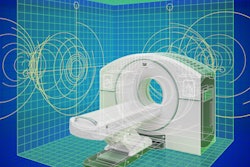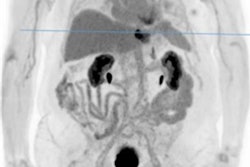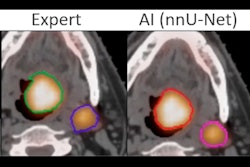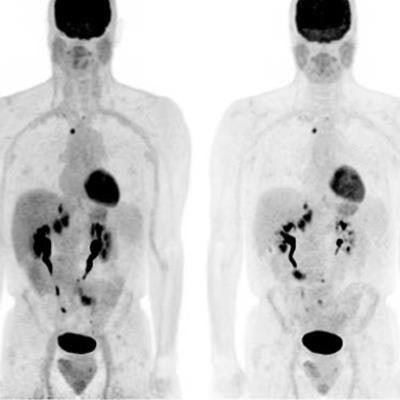
Dynamic whole-body PET is evolving fast and showing considerable clinical promise, a leading French molecular imaging expert told the opening plenary session at the annual congress of the European Association of Nuclear Medicine (EANM 2020). The technique is benefiting from artificial intelligence (AI)-based assistance to simplify the challenging and time-consuming tasks associated with the acquisition and analysis of data.
The advent of total-body PET prompts discussion as to whether the time to perform dynamic PET in routine has come, noted Prof. Irène Buvat, a physicist at the Curie Institute and France's national institute of health and medical research (Institut national de la santé et de la recherche médicale, INSERM). Speaking on 22 October, she explained that performing dynamic PET enables the investigation of tracer pharmacokinetics through the acquisition of dynamic images and modeling.
Also, published evidence strongly suggests that parametric images from dynamic PET facilitate image interpretation or carry significant prognostic value (e.g., using Patlak analysis, the tumor contrast can be clearly much higher on the Ki image compared with the standardized uptake values [SUV] image). Dynamic PET protocols are now available on some vendors' PET scanners, she added.
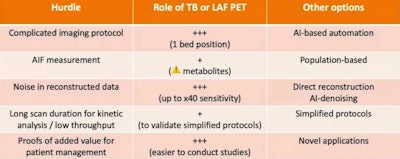 Table shows hurdles facing dynamic PET and role of total-body (TB) or long-axial field-of-view (LAF) PET. All images courtesy of Prof. Irène Buvat, Curie Institute, INSERM.
Table shows hurdles facing dynamic PET and role of total-body (TB) or long-axial field-of-view (LAF) PET. All images courtesy of Prof. Irène Buvat, Curie Institute, INSERM.Dynamic whole-body PET involves dynamic data acquisition over an extended axial range, capturing tracer kinetic information not available with conventional static acquisition protocols. It can be performed within reasonable clinical imaging times, and enables the generation of multiple types of PET images with complementary information in a single imaging session. It can be used to produce multiparametric images of Patlak slope (influx rate) and intercept (or "distribution volume"), while also providing a conventional SUV-equivalent image for certain protocols.
Buvat said that in any discussion of the technology, two important questions must be addressed: Why is dynamic PET scanning not used much? Can total-body PET and long-axial field-of-view (FOV) PET be game changers?
Complicated protocols
The first hurdle is the complicated acquisition protocol of dynamic PET. However, using a total-body PET scanner, the protocol is highly simplified because everything can be captured in one acquisition, she commented. With rapid-time sampling at the beginning of the acquisition, doctors can obtain the data needed to estimate an image-derived input function, followed by any time sampling for a dynamic series of whole-body images without any bed motion.
This said, another reason dynamic imaging isn't used is that to explore dynamic scans, and to perform subsequent kinetic analysis, arterial input function measurement is needed, Buvat continued. The gold standard approach to obtain arterial input function is to perform arterial blood sampling, but this is too invasive for routine use, and an alternative approach is to derive the arterial input function from the image by drawing a small region of interest in a large arterial vessel such as the descending aorta.
"Using current PET/CT or PET/MR scanners this works only if the large vessel is within the field-of-view. However, with total-body PET an image-derived input function can always be measured as large vessels are always included in the field-of-view," she said.
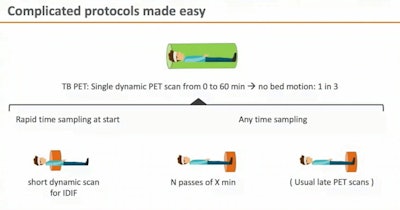 Total-body PET will allow simplification of complicated dynamic PET protocols.
Total-body PET will allow simplification of complicated dynamic PET protocols.Image-derived input function is still not completely satisfactory, she noted, because it cannot be easily corrected for the fraction of radioactive metabolites. However, the availability of total-body PET makes it possible to precisely investigate the impact of the volume of interest (VOI) used for deriving the input function. By using a fine time sampling, it even enables the definition of a dual input function to distinguish between the left ventricle and right ventricle blood supply, she added.
Denoising data
Another limitation encountered in dynamic PET is that it generates many relatively short time frames that have to be reconstructed. In current PET/CT, a short time frame is associated with noisy sinograms, hence noisy reconstructed images and as a result parametric images calculated from dynamic PET such as a Ki image from a Patlak analysis, are often noisier than usual SUV images.
However there are at least three approaches to avoid this high noise in parametric imaging, EANM delegates heard. The first is to reconstruct directly the kinetic parameters, instead of first reconstructing the images and then performing a voxel-wise fit to the parametric model.
A second approach is using deep learning methods for so-called denoising. Third, the use of total-body PET hugely increases sensitivity resulting in Ki images that are of excellent quality compared with SUV images. So again total-body PET or large actual field of view PET can help to solve the problem of noise in dynamic PET scans.
Clinical application
Another constraint is that dynamic PET scans have to last long enough to capture the tracer kinetics. Typically the acquisitions are between 30 and 60 minutes, considerably reducing patient throughput.
One solution, however, involves developing simplified protocols. Ki images can be obtained using a simplified protocol involving only two scans of five minutes each and the use of a population-based input function.
 Prof. Irène Buvat.
Prof. Irène Buvat."The availability of total-body PET could actually help us design and validate simplified protocols that could be more compatible with daily routine," she continued.
Although there is evidence that dynamic PET has added value in certain applications, more data was needed to clarify the difference it makes to patient management, she continued, pointing to how in one recent study involving over 100 patients with over 300 lesions, the authors revealed that four false positives seen on SUV images were avoided using the parametric images.
There now remains the need for more studies to determine how dynamic PET fits in the future of both clinical PET and PET-based research for lesion detection and characterization, patient monitoring, prognostication, characterization of heterogeneity of tumors within a single patient, and for pharmaco-imaging.
The availability of total-body PET will facilitate these studies and will contribute to overcoming the hurdles of dynamic PET and to its development, she told delegates.
"This should help us determine the role dynamic PET should play in the future both for the clinics and in research. Importantly, the availability of dynamic PET might help us discover new applications that are currently not possible with conventional PET/CT and PET/MR scanners," Buvat concluded.
Editor's Note: The graphic used to introduce this topic on our homepage shows maximum intensity projection and transaxial whole-body dynamic images in a lung cancer case. Courtesy of Dr. Steven Cho et al, the University of Wisconsin-Madison, and the Society of Nuclear Medicine and Molecular Imaging.




